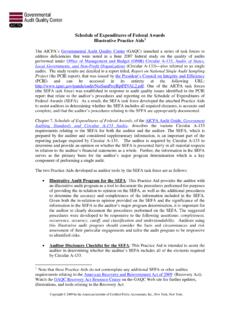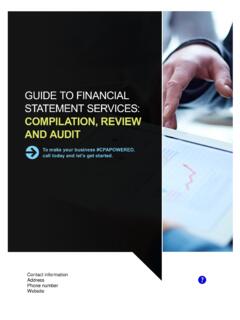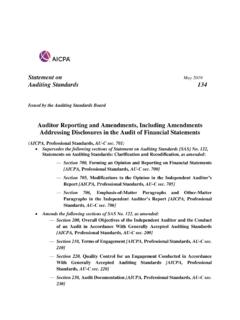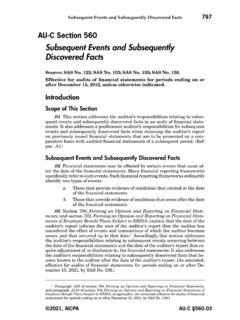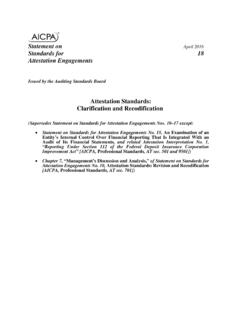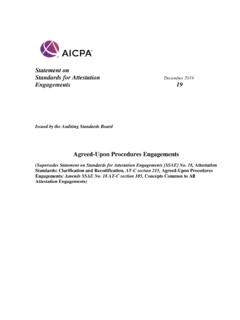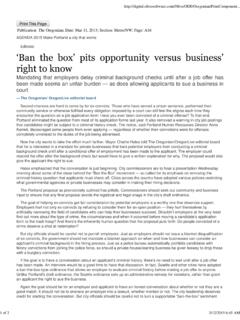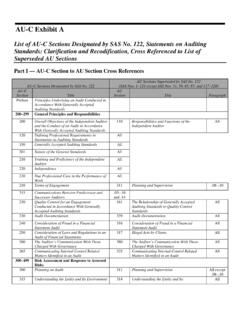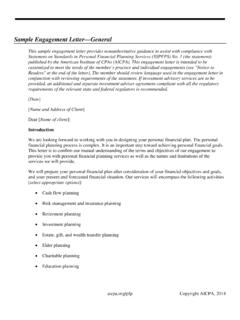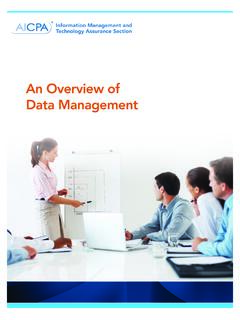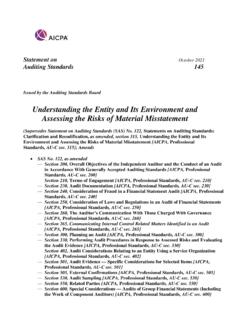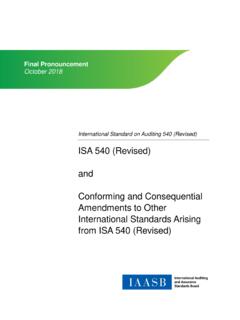Transcription of Audit Risk and Materiality in Conducting an Audit - AICPA
1 Audit Risk and Materiality in Conducting an Audit1647AU Section 312 Audit Risk and Materiality in Conductingan Audit (Supersedes SAS No. 47.)Source: SAS No. section 9312 for interpretations of this for audits of financial statements for periods beginning on or afterDecember 15, 2006. Earlier application is section provides guidance on the auditor's consideration of auditrisk and Materiality when performing an Audit of financial statements in accor-dance with generally accepted auditing standards. Audit risk and materialityaffect the application of generally accepted auditing standards, especially thestandards of fieldwork and reporting, and are reflected in the auditor's standardreport.
2 Audit risk and Materiality , among other matters, need to be consideredtogether in designing the nature, timing, and extent of Audit procedures and inevaluating the results of those existence of Audit risk is recognized in the description of the re-sponsibilities and functions of the independent auditor that states, "Becauseof the nature of Audit evidence and the characteristics of fraud, the auditor isable to obtain reasonable, but not absolute, assurance that material misstate-ments are detected."1 Audit risk2is the risk that the auditor may unknowinglyfail to appropriately modify his or her opinion on financial statements that arematerially concept of Materiality recognizes that some matters, either in-dividually or in the aggregate, are important for fair presentation of finan-cial statements in conformity with generally accepted accounting principles,4while other matters are not important.
3 In performing the Audit , the auditor is1 See section 110,Responsibilities and Functions of the Independent Auditorand section 230,DueProfessional Care in the Performance of Work, for a further discussion of reasonable addition to Audit risk, the auditor is also exposed to loss of or injury to his or her professionalpractice from litigation, adverse publicity, or other events arising in connection with financial state-ments audited and reported on. This exposure is present even though the auditor has performed theaudit in accordance with generally accepted auditing standards and has reported appropriately onthose financial statements.
4 Even if an auditor assesses this exposure as low, the auditor does not per-form less extensive Audit procedures than otherwise is appropriate under generally accepted definition ofaudit riskdoes not include the risk that the auditor might erroneously concludethat the financial statements are materially misstated. In such a situation, the auditor ordinarilyreconsiders or extends Audit procedures and requests that management perform specific tasks toreevaluate the appropriateness of the financial statements. These steps ordinarily lead the auditorto the correct conclusion.
5 This definition also excludes the risk of an inappropriate reporting decisionunrelated to the detection and evaluation of a misstatement in the financial statements, such as aninappropriate decision regarding the form of the auditor's report because of a limitation on the scopeof the concepts of Audit risk and Materiality also are applicable to financial statements presentedin conformity with a comprehensive basis of accounting other than generally accepted accounting prin-ciples as defined in section 623,Special Reports.
6 References in this section to financial statements pre-sented in conformity with generally accepted accounting principles also include those Standards of Field Workconcerned with matters that, either individually or in the aggregate, could bematerial to the financial statements. The auditor's responsibility is to plan andperform the Audit to obtain reasonable assurance that material misstatements,whether caused by errors or fraud, are in the Context of an auditor's consideration of Materiality is a matter of professionaljudgment and is influenced by the auditor's perception of the needs of users offinancial statements.
7 The perceived needs of users are recognized in the discus-sion of Materiality in Financial Accounting Standards Board (FASB) Statementof Financial Accounting Concepts No. 2,Qualitative Characteristics of Account-ing Information, which definesmaterialityas "the magnitude of an omissionor misstatement of accounting information that, in the light of surroundingcircumstances, makes it probable that the judgment of a reasonable personrelying on the information would have been changed or influenced by the omis-sion or misstatement .
8 " That discussion recognizes that Materiality judgmentsare made in light of surrounding circumstances and necessarily involve bothquantitative and qualitative an Audit of financial statements, the auditor's judgment as to mat-ters that are material to users of financial statements is based on considerationof the needs of users as a group; the auditor does not consider the possible effectof misstatements on specific individual users, whose needs may vary evaluation of whether a misstatement could influence economicdecisions of users, and therefore be material , involves consideration of the char-acteristics of those users.
9 Users are assumed an appropriate knowledge of business and economic activitiesand accounting and a willingness to study the information in the fi-nancial statements with an appropriate diligence; that financial statements are prepared and audited tolevels of Materiality ; the uncertainties inherent in the measurement of amountsbased on the use of estimates, judgment, and the consideration of fu-ture events; appropriate economic decisions on the basis of the informationin the financial determination of Materiality , therefore, takes into account how users withsuch characteristics could reasonably be expected to be influenced in makingeconomic and Causes of representation in the auditor's standard report regarding fair pre-sentation, in all material respects, in conformity with generally accepted ac-counting principles indicates the auditor's belief that the financial statements,5 See paragraphs.
10 59 and .60 for further guidance regarding qualitative considerations in evalu-ating Audit determining Materiality in audits of financial statements or other historical financialinformation prepared for a special purpose, the auditor considers the needs of specific users in thecontext of the objective of the Risk and Materiality in Conducting an Audit1649taken as a whole, are not materially misstated. Misstatements can result fromerrors or fraud7and may consist of any of the inaccuracy in gathering or processing data from which financialstatements are difference between the amount, classification, or presentation of a re-ported financial statement element, account, or item and the amount,classification, or presentation that would have been reported undergenerally accepted accounting omission of a financial statement element, account.
